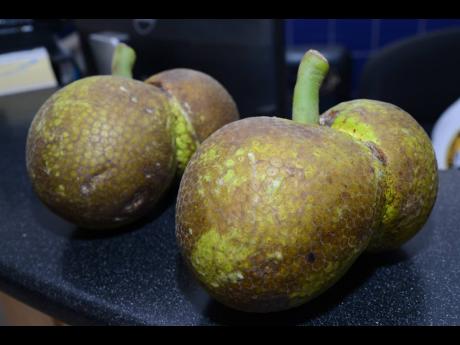Medicinal properties of the breadfruit
Breadfruit ( Artocarpus altilis) is the fruit of the breadfruit tree, though it is often referred to as a vegetable when consumed before it is fully ripe. It comes from the same family as jackfruit and mulberry.
Similar to bananas and plantains, the breadfruit can be enjoyed ripe as a sweet fruit or underripe as a less-sweet vegetable. When consumed as a vegetable, breadfruit is picked while it is starchy and then boiled or roasted in an underground oven with hot rocks. Some people enjoy it stuffed with coconut and roasted, sliced and fried in palm sugar or syrup until crisp and brown, or cooked with coconut and sugar.
This starchy food is high in carbohydrates and fibre while low in fat, making it a good addition to healthy eating plans. It contains several vital nutrients, like B vitamins, potassium and vitamin C.
According to Dr Ina Vandebroek, co-author of the book Popular Medicinal Plants In Portland and Kingston, Jamaica and senior lecturer in the Department of Life Sciences at The University of the West Indies, Mona, the plants produce an array of phytochemicals, which are known as secondary metabolites, that help them as a defence against predators or attract pollinators.
“These phytochemicals possess medicinal properties that are beneficial to humans. The medicinal efficacy of a plant is evaluated through various stages. Initial testing involves in vitro studies on cells in laboratory conditions, followed by in vivo experiments on laboratory animals. The highest level of assessment for a plant’s medicinal potential is through clinical studies involving human subjects,” Dr Vandebroek said.
In Jamaica, breadfruit has a status as a tonic food, and the tree is common across the island. Researchers have acknowledged the fruit’s nutritional qualities, noting its abundant complex carbohydrates, low fat content, and essential amino acids.
REQUIRES MONITORING
All parts of the breadfruit tree are used medicinally in the Caribbean and Pacific, especially the latex, leaf, and inner bark. In the West Indies, the yellowing leaf is brewed and drunk to lower high blood pressure and to treat asthma. The leaf tea is also believed to control diabetes.
“In Jamaica, breadfruit leaves are used in the treatment of high blood pressure, either through direct application to the head, or by preparation as a tea for consumption. A lesser-known application involves steeping breadfruit leaves and flowers in water for cosmetic use. Typically, an ounce-to-a-pint ratio is recommended for this preparation,” Dr. Vandebroek said.
It is crucial, she said, to differentiate between the medicinal properties of a plant validated through laboratory testing or human clinical trials, and the traditional medicinal practices of local communities, which form an integral part of their daily healthcare routines.
“An overview of laboratory studies that have been conducted using extracts or isolated chemical compounds from various parts of the breadfruit plant have revealed several potential benefits, including antimalarial and anti-tuberculosis activity, an anti-cholesterol effect, anthelmintic properties, mosquito repellent qualities, and an antihypertensive effect, among others,” Dr Vandebroek said.
“Notably, researchers at the UWI, Mona, have investigated the potential mechanisms underlying the blood pressure-lowering effects of a water extract from breadfruit leaves in rats. However, it is important to note that these findings should not be extrapolated to human use without clinical studies,” Dr Vandebroek added.
Although the fruit is seasonal, the yellowing leaf can be used medicinally all year long. Local community members advise to collect the leaf before the sun goes down and to not let it drop off the tree.
When considering the use of breadfruit leaf tea for medicinal purposes in humans, caution is advised, especially in the absence of human clinical studies. This precaution is particularly crucial for pregnant or breastfeeding women, and children. Hypertension being a serious medical condition, she said, requires monitoring by a qualified healthcare provider. Individuals who choose to self-administer breadfruit leaf tea should tell this to their physician.
OTHER MEDICINAL BENEFITS OF BREADFRUIT:
• All parts of Artocarpus altilis are used medicinally in the Caribbean and Pacific, especially the latex, leaf tips, and inner bark. In the West Indies, the yellowing leaf is brewed and drunk to lower high blood pressure and to treat asthma. The leaf tea is also believed to control diabetes.
• In the Caribbean and Pacific, the latex is massaged into the skin to treat broken bones and sprains and is bandaged on the spine to relieve sciatica (pain affecting the back, hip, and outer side of the leg, caused by compression of a nerve). It is commonly used to treat skin ailments and fungus diseases such as ‘thrush’, which are also treated with crushed leaves. Diluted latex is taken internally to treat diarrhoea, stomach ache, and dysentery.
• The sap from the crushed stems or leaves is used to treat ear infections or sore eyes. The root is astringent and used as a purgative; when macerated, it is used as a poultice (compress) for skin ailments. The bark is also used to treat headache in several islands.
SOURCE: Popular Medicinal Plants In Portland, and Kingston, Jamaica; Ina Vandebroek and David Picking; Faculty of Science and Technology, The University of the West Indies,Mona



